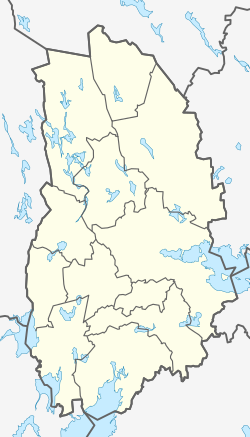Örebro, Sweden
| Örebro | ||
|---|---|---|

|
||
|
||
| Coordinates: 59°16′26″N 15°12′27″E / 59.27389°N 15.20750°ECoordinates: 59°16′26″N 15°12′27″E / 59.27389°N 15.20750°E | ||
| Country | Sweden | |
| Province | Närke | |
| County | Örebro County | |
| Municipality | Örebro Municipality | |
| Charter | 1404 | |
| Area | ||
| • City | 1,380.11 km2 (532.86 sq mi) | |
| Elevation | 34 m (112 ft) | |
| Population (2015, 2010 for urban area) | ||
| • City | 143,098 | |
| • Density | 2,172/km2 (5,630/sq mi) | |
| • Urban | 107,038 | |
| • Metro | 188,100 | |
| Demonym(s) | Örebroare | |
| Time zone | CET (UTC+1) | |
| • Summer (DST) | CEST (UTC+2) | |
| Postal code | 701 xx, 703 xx | |
| Area code(s) | (+46) 19 | |
| Website | www |
|
| ^ Including Örebro, Kumla, Hallsberg and Lekeberg municipalities. | ||
Örebro [œrɛˈbruː] is a city with 107,038 inhabitants, the seat of Örebro Municipality and the capital of Örebro County in Sweden. It is the seventh largest city in Sweden and one of the largest inland hubs of the country. It is located near the lake of Hjälmaren, although a few kilometres inland along small river Svartån.
Örebro is home to Örebro University, a major university hospital, a medieval castle, the water park Gustavsvik as well as several large shopping malls and the Oset-Rynningeviken nature reserve at the lakefront.
Örebro received its Royal Charter and city privileges not later than 1404.
Örebro literally means penny bridge. The geography looks, with a stream Svartån draining into the lake Hjälmaren. The location became a natural seat of commerce in the Scandinavian Middle Ages and is mentioned in print in the 13th century. Old buildings from the early days include the foundations of the city church, a building which has undergone several modifications. The natural center of the city is otherwise the magnificent Örebro Castle, situated on an islet in the Svartån, and dividing the town into a northern and a southern part. This castle was constructed during the stewardship of Birger Jarl during the early 13th century and then modified and enlarged during the reign of King Gustav Vasa in the 1560s.
Notable events in Örebro's history include the national diet meeting at Örebro in 1810, where Jean-Baptiste Bernadotte was elected crown prince of Sweden.
...
Wikipedia



